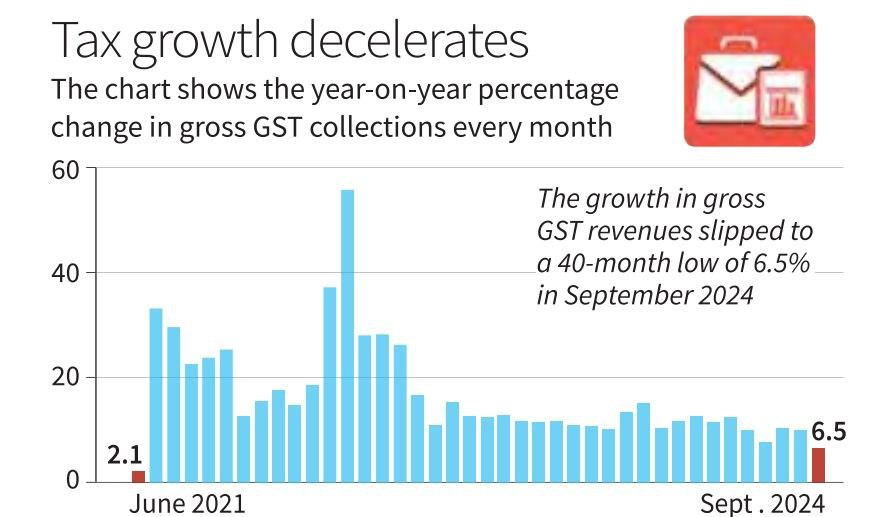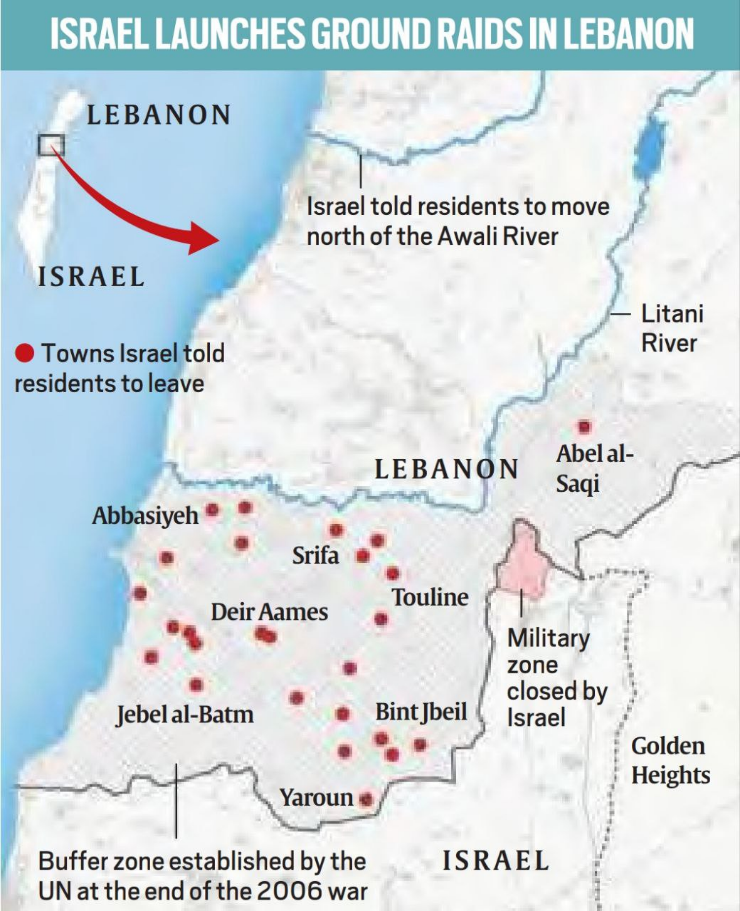1. GST Growth Slowed in September 2024: Key Points
- Overall Growth Slowdown:
- Gross Goods and Services Tax (GST) collections showed a significant slowdown, dropping to a 40-month low of 6.5% growth in September 2024.
- The gross GST revenue for September 2024 amounted to ₹1,73,240 crore, marking a 1% dip compared to the previous month (August 2024).
- Net GST Receipts:
- After adjusting for refunds, the net GST receipts increased by 3.9% compared to September 2023, reflecting the slowest growth this financial year.
- Net collections in September 2024 stood at ₹1,52,782 crore, which was 1.5% higher than in August 2024.
- State-Wise Revenue Impact:
- Seven states witnessed a contraction in GST revenues during September 2024, while Gujarat reported flat revenues.
- Domestic vs. Import Revenues:
- Domestic revenue growth was 5.9%, whereas import-related revenues grew at a higher rate of 8% for the third consecutive month, showing a higher reliance on import-based GST growth.
- GST Refunds:
- Domestic refunds rose sharply by 24.3% in September 2024, following a 38% increase in August 2024.
- Export-related Integrated GST (IGST) refunds grew by 39.2%.
Overall GST refunds were up by 31% in September compared to the previous year, indicating a steady increase in refunds.
2. Reconstitution of Monetary Policy Committee (MPC) – October 2024
- Reconstitution Details:
- The Central Government has reconstituted the Monetary Policy Committee (MPC) ahead of the RBI’s monetary policy review scheduled for October 7–9, 2024. Three new external members have been appointed to the MPC for a four-year term
- Tenures Ending: The terms of the outgoing members Ashima Goyal, Jayanth R Varma, and Shashanka Bhide ended on October 4, 2024.
- Role and Functions of the MPC:
- The MPC determines the policy interest rate (benchmark repo rate) to achieve the inflation target.
- It consists of six members: three from the RBI and three external members appointed by the Central Government.
- The RBI Governor serves as the ex-officio chairperson, and the Deputy Governor in charge of monetary policy is also a member.
- Legal Framework and Objectives:
- The MPC was first constituted in September 2016 under the Reserve Bank of India Act, 1934, with its legal framework revised in 2016 to give the MPC responsibility for inflation targeting.
- The MPC’s primary mandate is to maintain price stability while considering economic growth.
- It targets an inflation rate of 2–6% as per the flexible inflation targeting framework.
- Upcoming Monetary Policy Review (October 2024):
- The upcoming review will focus on interest rates amid inflationary pressures and economic conditions.
- The expectation is for the RBI to maintain the repo rate at 5%, the same rate that has been held steady since February 2023.
- The key concern will be inflation control, especially in light of evolving global and domestic conditions.
- Significance of the MPC:
- It brings a structured framework for monetary policy, providing a collective decision-making body to enhance the transparency and accountability of the RBI’s monetary decisions.
External members contribute expertise in economics, financial markets, and policy advocacy, influencing key decisions on interest rates to balance inflation and growth.
3. Iran Fires Missiles at Israel
- Event Overview:
- Iran launched a barrage of 180 ballistic missiles towards Israel in response to Israeli military actions in Lebanon, specifically targeting Hezbollah leadership allied with Tehran.
- Explosions were reported in Jerusalem and the Jordan River Valley, triggering air raid alarms and leading to Israelis seeking shelter.
- Israeli Response:
- Israeli military confirmed intercepting the missiles over the airspace of neighboring Jordan.
- Israel’s IDF (Israeli Defense Forces) had earlier anticipated such an attack, preparing the public to take shelter.
- Israeli ground troops had initiated raids into Lebanon earlier, targeting Hezbollah forces.
- Iran’s Position:
- The Islamic Revolutionary Guard Corps (IRGC) issued a warning, threatening “crushing attacks” if Israel retaliated.
- The IRGC justified the missile strike as being in line with the United Nations Charter, referencing a right to self-defense following an “attack on the sovereignty” of Iran.
- The missile launch was framed as a reaction to previous Israeli actions, including the killing of Hamas leader Ismail Haniyeh in Tehran in July.
- Military and Political Ramifications:
- Iran’s missile strike followed a period of restraint, as mentioned by Iranian authorities, but heightened tensions in the region following Israeli operations in Lebanon.
- Iran also announced the suspension of flights at Tehran International Airport after the missile strikes.
- This event marked a significant escalation between the two countries, with the risk of wider regional conflict involving Hezbollah in Lebanon and the broader Middle East dynamics.
- International Implications:
- The confrontation raised alarms in the international community, with potential implications for broader geopolitical stability in the Middle East.
The event underscores the volatile situation in the region, with potential repercussions for global diplomacy, security, and international relations.
4. Swachh Bharat Mission (SBM) – 10-Year Overview
- Introduction:
- Launched: October 2, 2014, by Prime Minister Narendra Modi as part of the Clean India campaign.
- Objective: To pay tribute to Mahatma Gandhi on his 150th birth anniversary by achieving a clean India.
- Divided into Two Phases:
- SBM-Gramin: Focus on rural areas.
- SBM-Urban: Focus on cities and urban areas.
- Main Targets of SBM:
- Open Defecation Free (ODF): The goal was to make India ODF by October 2, 2019.
- Behavioral Change: Campaigns to change public behavior toward cleanliness.
- Solid and Liquid Waste Management:
Solid Waste: Focus on waste segregation and recycling.
Liquid Waste: Wastewater management to ensure it is no longer harmful for human consumption.
- Achievements (as of 2024):
- Toilets Constructed: Over 100 million toilets built across India.
- ODF Achievement:
- Rural India declared ODF by October 2, 2019.
- Urban India: Most cities declared ODF by December 2019, except some regions (e.g., West Bengal).
- SBM-U 2.0: Launched in 2021 to focus on garbage-free cities and faecal sludge management.
- Individual Household Toilets: Government increased financial assistance from ₹10,000 (pre-SBM) to ₹12,000 under SBM.
- Solid Waste Management:
97% of wards segregate waste at source.
90% of households have 100% source segregation.
- Key Financial Allocations:
- Expenditure: ₹57,469.22 crore to states and UTs between 2014-2015 and 2018-2019.
- Budget for SBM-Urban: ₹62,009 crore.
- New Allocation (2020-2021): ₹1.4 lakh crore approved for SBM-U 2.0, focusing on city-level infrastructure.
- Future Targets:
- 100% of cities to have adequate solid waste management systems by 2025-2026.
- All 42,000 legacy landfill sites to be remediated by 2026.
- Impact of SBM:
- World Health Organization (WHO) Report (2018): 3 lakh diarrheal deaths were prevented due to SBM-G between 2014 and 2019.
- Universal Use of Toilets: A recent survey indicates significant improvement in sanitation practices.
- Health Improvements:
- Unsafe sanitation cases reduced by 199 million annually since the start of SBM in 2014.
- A study showed the annual reduction in diarrhea cases due to SBM intervention from 2003 to 2020.
Change in Rural Sanitation: By 2021, 53.1% of households practiced safe sanitation.



